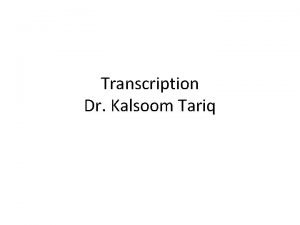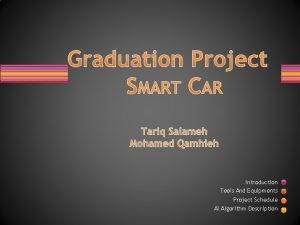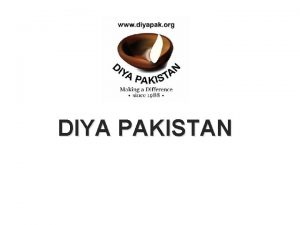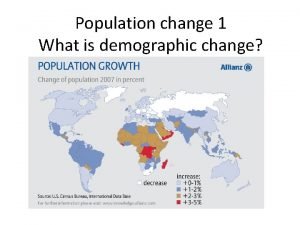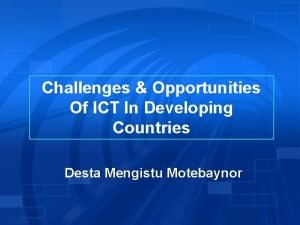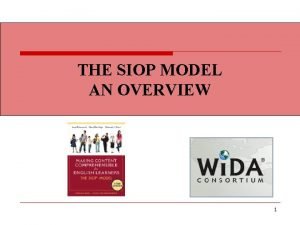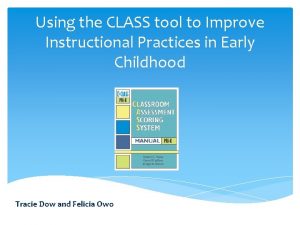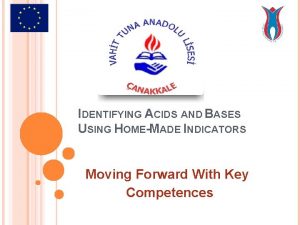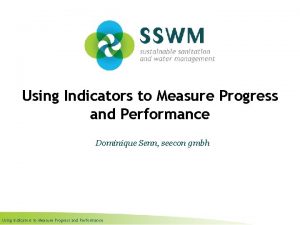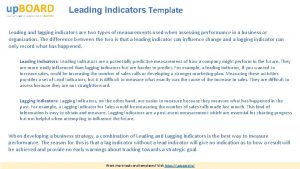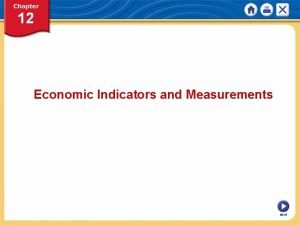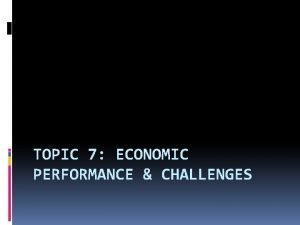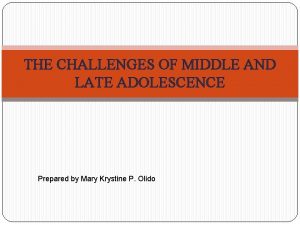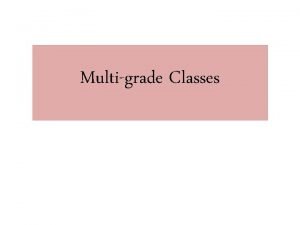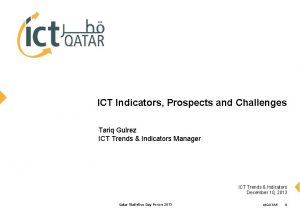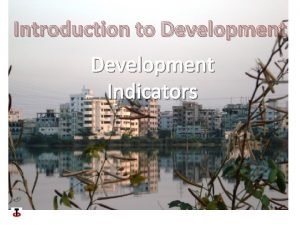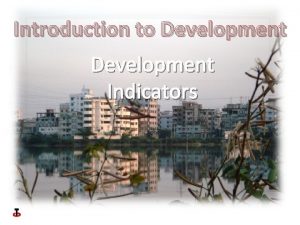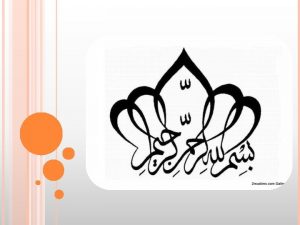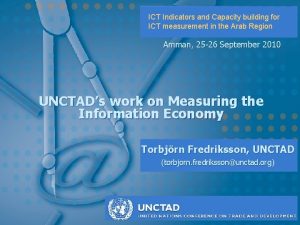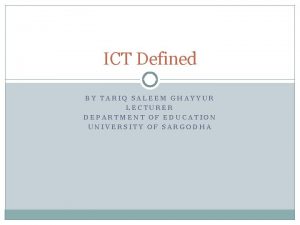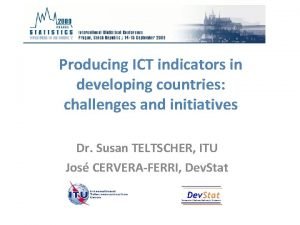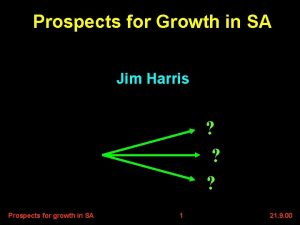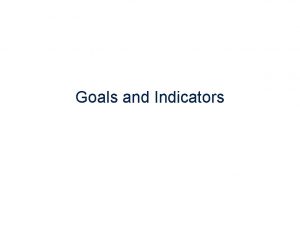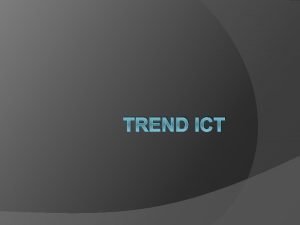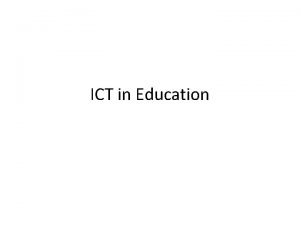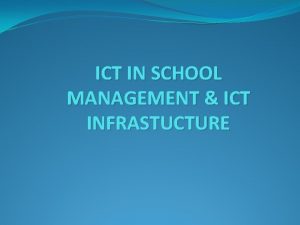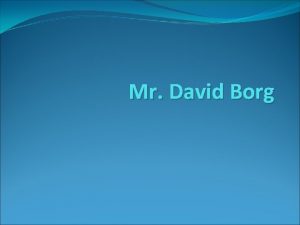ICT Indicators Prospects and Challenges Tariq Gulrez ICT























- Slides: 23

ICT Indicators, Prospects and Challenges Tariq Gulrez ICT Trends & Indicators Manager ICT Trends & Indicators December 10, 2013 Qatar Statistics Day Forum 2013 ict. QATAR 0

“You want to know the difference information and communication technologies make? Try to live without them…. ” - International Telecommunication Union (ITU) Qatar Statistics Day Forum 2013 ict. QATAR 1

Adoption of ICTs is growing rapidly in record numbers globally Mobile-cellular telephone subscriptions Households with Internet access Individuals using the internet Active mobile-broadband subscriptions Fixed-telephone subscriptions Fixed (wired) broadband subscriptions Globally, there is wide agreement that information and communication technologies (ICTs) are an important development enabler Source: ITU paper on producing indicators * Estimates Source: Measuring the Information Society Report 2013 4 Growth in Mobile-cellular penetration is flattening whereas Mobile Broadband continues to grow strongly (approx. 40 per cent annually since 2010) 4 Mobile Internet uptake and Household access to the Internet has also accelerated strongly (expected to reach a penetration rate of over 40 per cent globally by 2013 end) 4 Ericsson forecasts that there will be 6. 5 billion mobile-broadband subscriptions by 2018 Qatar Statistics Day Forum 2013 ict. QATAR 2

Measurement of ICT is important for policymakers but it is dynamic and evolving 4 Development of internationally comparable ICT statistics along with information on usage, attitude, emerging areas and barriers are essential for Qatar to be able to adequately design, implement, monitor and evaluate ICT policies 4 Measurement of ICT is difficult because of the: § Diverse and changing nature of ICT § Complexity of ICT impacts § Difficulties of illustrating a cause-and-effect relationship between the different variables Qatar Statistics Day Forum 2013 ict. QATAR 3

48 core ICT indicators are endorsed by international community for tracking access and usage of ICTs in the fast emerging information society 4 World Summit on the Information Society (WSIS) identified specific goals and targets 4 Fast emerging information society calls for statistics and indicators to monitor Access, Usage and Impact of information and communication technologies (ICTs) 4 Core international ICT indicators by the UN Statistical Commission: 1 ICT Infrastructure and Access 10 indicators 2 Access to, and Use of, ICT by Households and Individuals 13 indicators 3 Use of ICT by Businesses 12 indicators 4 ICT Sector and Trade in ICT goods 4 indicators 5 ICT in Education 9 indicators 48 indicators Qatar Statistics Day Forum 2013 ict. QATAR 4

Indicators from Administrative sources along with survey based Usage and emerging Impact indicators are required for policy purposes and monitoring progress in Qatar’s ICT Landscape Indicators on basic ICTs e. g. number of fixed telephone lines, mobile and Internet subscriptions, or availability of radios etc Advanced Usage and Attitude indicators No. of Internet users, their location concentration and Usage patterns i. e. what they do on the Internet etc. Provide important information and can fairly easily be produced based on administrative sources Have been collected for a longer time Required for designing effective ICT policies and taking strategic investment decisions ICT Impact indicators ICT Impact in terms of Inclusive Society, Business Innovation, and better Governance Areas: Social, Business and Economic (under development) Qatar Statistics Day Forum 2013 ict. QATAR 5

ict. QATAR monitors progress of ICT among key sectors crucial to the growth of Qatar’s knowledge-based economy Key Research Areas § Usage and Attitudes toward: Mobile technologies, Computers, Internet, Telecom services, e-Government services and Consumer protection, etc. § Web Presence 1) Households & Individuals 2) Businesses 3) Government § On-line Safety and Security § Satisfaction with technologies and services § Barriers to ICT Usage § Others: In the area of emerging technology trends Qatar Statistics Day Forum 2013 ict. QATAR 6

Households There has been a move toward ownership of multiple devices - inclined towards “on the go” devices. Overall, eighty-five percent of households now have a broadband connection 4 Fixed telephone lines continue to grow (against usual international observations) Indicators Fixed telephone lines 4 89 percent of households with Internet uses a fixed ADSL broadband connection Mobile cellular lines* 2010 2011 2012 270, 000 309, 000 394, 407 134% 135% 142% (2, 186, 447) (2, 302, 225) (2, 601, 210) * Population source: http: //www. qsa. gov. qa/eng/PS-Archive. htm Households Connectivity Avg. Units/HH 69% 1. 65 Mobile phone 99% Fixed telephone line 70% 95% Satellite Antenna (Dish) Tablet PC Computer (all types) 1. 62 1. 13 79% Broadband: 4 Mbps 10 Mbps 2% 1% 9% 2% 43% Broadband: 1 Mbps 4 Mbps 26% 30% Broadband: 256 - 1 Mbps 56% 0. 35 25% Laptop Desktop 3. 64 0. 74 Television Set Broadband: 10 Mbps+ 1. 57 84% Narrowband / dialup 0. 6 50% 92% 2. 52 Not sure 2% Percentage of Households Smartphone Internet Speeds in Households with Internet Access 4% 15% 12% Qataris Expatriates Source: Qatar’s ICT Landscape 2013 - Households and Individuals Qatar Statistics Day Forum 2013 ict. QATAR 7

Individuals Downloading movies/music is the most popular task over internet among mainstream individuals whereas e-Mail and Instant messaging are key activities of Smartphone users Types of Specific Tasks Performed Online by Mainstream Internet Users in the past 12 months (2012) 99% 98% 99. 6% 88% 87% 82% 70% 68% 69% 55% 50% 45% 37% 35% 32% 25% 24% 20% 16% Activities Performed on the Internet by a Smartphone User Compared to a User of Other Mobile Phones (2012) Smart Phone users who use Internet Other Mobile Phone users who use internet 77% Computer 2008 Internet 2010 Mobile Percentage of Respondents Conducting Activity Every Percentage of Respondents 85% Downloading/ watching movies/music Reading/downloading newspapers/mags Getting information about goods or services Finding, downloading, and installing software Getting information from general Govt. Org. . . Education and learning activities Playing or downloading games Using peer-to-peer file sharing Purchase or place orders for goods and. . . Online banking Getting information related to health/. . . Interacting with general govt. orgns Creating a Web page / a blog Percentage of Respondents ICT Penetration among mainstream Individuals 75% 66% 58% 49% 54% 32% 27% 2012 E-mail Instant messaging Social networking IP telephony Source: Qatar’s ICT Landscape 2013 - Households and Individuals Qatar Statistics Day Forum 2013 ict. QATAR 8

Business Increased number of organisations receive and place orders online but small businesses lag behind. A quarter of all establishments in Qatar use one or more social media 2010 75% 74% 64% Overall 2012 57% 58% 53% Small (1 -9) Medium (10 - Large (50 -249) Internet Penetration Percentage of Businesses 2008 2010 66% 59% 51% Overall 2012 90% 91% 88% Very Large (250+) 95% 100% 99% 98% 100% 48% 38%36% Small (1 -9) Medium (1049) Incidence of receiving and placing online 70% orders 69% 61% 56% Large (50249) 62% 61% 37% 35% 19% Overall Small (1 -9) Medium (10 - Large (50 Very large 49) 249) (250+) Receiving online orders Placing online orders Use of social media for Marketing or customer service activities Percentage of Establishments Percentage of Businesses 2008 100% 97% 94% 100%100% Percentage of Establishments Computer Penetration Very Large (250+) 47% 24% Overall 30% 34% 19% Small (1 -9) Medium (1049) Large (50249) Very Large (250+) Source: Qatar’s ICT Landscape 2013 - Business Qatar Statistics Day Forum 2013 ict. QATAR 9

Business Communication - related activities performed on internet are less prevalent among small establishments Internet Activities: Communication related 100% 99% Percentage of Establishments 88% 86% 65% 52% 48% 50% 47% 34% 33% 36% 30% 23% 18% 22% 24% Overall Small (1 -9) Sending or receiving e-mails 22% Medium (10 -49) Getting information about goods or services Large (50 -249) Vo. IP/videoconferencing Very Large (250+) Instant messaging/Bulletin boards Percentage of Establishments Presence of ICT related staff 99% 83% 4 There were an estimated 27, 000 technology specialists working across all businesses in Qatar 61% 43% 4 Establishments in Qatar plan to add 8 percent more ICT professionals in 2013 25% Overall Small (1 -9) Medium (10 - Large (50 -249) Very large (250+) Source: Qatar’s ICT Landscape 2013 - Business Qatar Statistics Day Forum 2013 ict. QATAR 10

Government Comprehensiveness of Government websites has increased significantly. 65 percent of employees who use a PC have access to the Internet at the office and Internet is mostly used for communicating with colleagues Comprehensiveness of Government Websites 51% Tasks Performed by Government Employees at work Using the Internet 29% 30% 22% Sending emails with attached files (documents, pictures, etc. ) 7% 0% No public information displayed on our website 2008 All public information available online on our website 2010 2013 Usage of ICTs by Government Employees PC - Desktop 99% Landline (telephone) 97% Printers 64% 78% Communicating with colleagues 74% 77% Scheduling business appointments 55% 61% Communicating with citizens and residents 55% 57% 13% Checking a receipt of work-related payments 9% 12% Placing orders for equipment/supplies 48% Standard Mobile Phone Finding, downloading, and installing software 36% Laptop Tablets Searching for work-related information Keeping viruses, spyware, and adware off your computer 91% Smartphone 59% 88% Percentage of Respondents 2% 94% 99% Sending work-related emails 14% 2010 12% 2013 28% 10% 26% 11% Source: Qatar’s ICT Landscape 2013 - Government Qatar Statistics Day Forum 2013 ict. QATAR 11

Government Despite the availability and growth of online channels, face-to-face interaction is still the most popular channel used by government organisations to communicate with the public Channels of Interaction with Citizens/Residents among Government 95% 92% Face-to-face 87% Organization website 79% 92% Telephone call centers 74% Email 63% 68% Traditional media 45% 61% Social media 45% It is blocked in my organization 32% It is not relevant to my work 16% My organization discourages usage of online media 7% Internet speed is too slow 7% Not secure 5% Not enough websites in Arabic 2% I am not aware of online media 1% 39% Mobile applications Government Internet portal Pressure of work, not enough time 71% 66% SMS Hukoomi portal Barriers to Usage of Online Media for Work-Related Purposes by Government Employees 92% 29% 50% 26% 47% Currently Others 1% No barriers 3% Don't know 1% Through 2016 Source: Qatar’s ICT Landscape 2013 – Government IT Executives Qatar Statistics Day Forum 2013 ict. QATAR 12

Government 29 percent of IT Executives cited the lack of required employee skills in the use of ICT technologies. 30 percent of government Employees cited work-related pressures and lack of time as limitations on their ICT use at work Factors Limiting Government Employees from Barriers of ICT for Government No barriers at all 50% 30% Pressure of workload, not enough time Lack of in-house technical expertise 29% Unable to hire IT professionals with the required skills 26% Budget constraints Company-specific policy around security of documents and. . . 51% No limitations to ICT use at work 16% 11% Lack of budget for staff training on new technologies 11% Employee resistance 11% Scale of organization 3% Lack of trust in ICT (security and privacy issues, for example) 3% 11% Limited access to the Internet 8% Lack of security in Internet transactions No budget for staff ICT training cours. . . 5% Lack of websites in Arabic relevant to. . . 5% Lack of skills required to use. . . 4% Websites of Qatari organizations. . . 4% Lack of trust in ICT (e. g. , . . . 3% Technology is too complicated 3% The websites of Qatari organizations. . . 2% Internet not available at work 1% No benefit in incorporating ICT into. . . 1% Others 1% Source: Qatar’s ICT Landscape 2013 – Government Qatar Statistics Day Forum 2013 ict. QATAR 13

Qatar’s ICT Landscape Reports track important ICT indicators among key sectors in Qatar – Households, Businesses and Government Qatar Statistics Day Forum 2013 ict. QATAR 14

Assessment of Qatar’s Performance on Network Readiness Index (benchmarking against high-income group average) 2013 2012 23 28 14 15 1 st pillar: Political and regulatory environment 18 27 5 2 nd pillar: Business and innovation environment 12 2 4 44 59 3 rd pillar: Infrastructure and digital content 35 27 4 th pillar: Affordability 103 111 5 13 16 25 6 th pillar: Individual usage 16 26 7 th pillar: Business usage 27 26 8 th pillar: Government usage 5 22 23 32 9 th pillar: Economic impacts 33 34 10 th pillar: Social impacts 8 21 Overall NRI 1 Political and regulatory environment 7 Sub. Index A. Environment sub index B. Readiness sub index 5 th pillar: Skills C. Usage sub index D. Impact sub index Y 2013: 144 countries 10 Social impact 9 Economic impacts 6 2 Business and innovation environment 3 3 Infrastructure and digital content 2 1 8 Government usage 4 Affordability 7 Business usage 5 Skills High-income Group average Qatar 6 Individual usage Y 2012: 142 countries Qatar Statistics Day Forum 2013 ict. QATAR 15

ICT is widespread and grazes across sectors. Thus, producing statistics for indicators dependent on other sectors demands active participation from the sectors 2013 Value Rank S No NRI Indicators Primary Sector 11. 6 Education 28 101. 7 Education Adult literacy rate, % 56 96. 3 Education 1. 03 Judicial independence*, 1 -7 (best) 10 6. 2 Legal 1. 01 Effectiveness of law-making bodies*, 1 -7 (best) 13 5. 0 Legal 2. 04 No. days to start a business 9 9 Business 2. 05 No. procedures to start a business 8 8 Business 7. 04 Business-to-business Internet use*, 1 -7 (best) 13 6. 0 Business 7. 05 Business-to-consumer Internet use*, 1 -7 (best) 33 5. 2 Business 3. 01 Electricity production, k. Wh/capita 15, 519. 2 2. 07 Tertiary education gross enrollment rate, % 108 5. 03 Secondary education gross enrollment rate, % 5. 04 6 4 Active participation from all key sectors are required for ICT progress monitoring 4 Publish latest sectoral statistics with international organisations for accurate benchmarking Indicators followed by an asterisk (*) are measured on a 1 -to-7 (best) scale Qatar Statistics Day Forum 2013 ict. QATAR 16

Major challenges in production of ICT indicators … Pace of ICT development and complexity Difficulty in understanding concepts by interviewers and respondents ICT economic issues in accounting system § Rapid pace of development (e. g. connectivity and access to networks, mobile devices and applications for e-business processes) require statisticians to get familiar with the technologies and their definitions § Process of technological convergence makes it even more complex, since devices (such as mobile phones) increasingly allow access and use of new types of services § Concepts such as type of ICT access and use may be difficult to understand for respondents and interviewers § This requires preparing training manuals and respondents‘ instructions specific to ICT-related questions (covering a large variety of readers - from the most ICT literate to the less familiar) § Some economic issues related to ICTs (such as e-commerce value or impact of ICT on economic performance) are not readily obtainable from accounting systems of businesses, and therefore difficult to collect in questionnaires § Alternatives are being devised and easy-to-answer questions are under development (for example, on placing or receiving purchase orders by Internet) Qatar Statistics Day Forum 2013 ict. QATAR 17

Major challenges in production of ICT indicators Complexity of impact measurement Some technical constraints in conducting survey based research § Measuring impacts in ICT is even more complicated because of its diversity and rapidly changing nature § Many ICTs are general-purpose technologies, which facilitate change and thereby have indirect impacts that are social or environmental § There a number of different ICTs, with different impacts in different contexts and countries. They include goods, such as mobile phone handsets, and services, such as mobile telecommunications services, which change rapidly over time § Lack of recent/updated population frames, business registers and forecasts § Difficulties due to restricted coverage in collecting information on continuously emerging ICT issues from individuals and households § Low response rates from businesses § Estimates on share of informal economy § Statistical classifications adapted to international standards § Definition of statistical units – enterprises vs. establishments Qatar Statistics Day Forum 2013 ict. QATAR 18

Suggestions and future collaboration areas 4 Efforts across sectors should be synergized in developing Sectoral statistics and maintaining latest publications with international organisations for facilitating accurate international benchmarking 4 National strategy should be supported by actionable guidelines for supporting development of high quality statistics 4 Open data policy and facilitation in developing central national database 4 Detailed National frame of reference statistics and forecasts for households and individuals, businesses and government i. e. sectoral revenues, enterprises, establishments, ICT workforce, occupied households units, businesses, mainstream individuals, labour camp and transient workforce, government employees etc. 4 Estimated annual calendar of publications 4 Guidance and training on latest developments in the area of national statistics, national accounts, development of sampling plans and data documentation 4 Provision of joint representation in work groups/committees and facilitating development of high quality ICT sectoral statistics (other than Economic statistics) 4 ICT should be treated as a separate sector in accordance with the latest ISIC classification and ict. QATAR should be actively engaged in developing economic ICT statistics Qatar Statistics Day Forum 2013 ict. QATAR 19

Appendix: National Frame of reference data is required for analysis purposes. Availability of detailed interlock for the below mentioned is crucial for developing robust sampling plan and conducting analysis Households & Individuals Business and Government ICT Producing sector • Age • Number of establishments • ICT sector workforce (number of persons employed) • Municipality • Number of enterprises • Value added in the ICT Sector • Nationality • Number of employees • Gender • By main economic activities • Education levels • Value added in the ICT Sector • Occupation • Economic Activities • Family size • Municipality • Time series and forecast • Government employee data • Value added in the Business sector (in QAR) Historical data, Forecast, and detailed interlocks Qatar Statistics Day Forum 2013 ict. QATAR 20

Appendix: Approaches in measuring ICT 1) Case Studies 4) Analytical Techniques Used to explore causation within their scope. Maybe small scale and project based; longitudinal for examining changes over time Generally very detailed, and can involve a number of qualitative and/or quantitative data sources The main techniques are econometric modeling using regression, growth accounting and input/output analysis. Econometric regression models have also been used in other areas of measurement e. g. measuring the impacts of ICT use on educational outcomes 5) Administrative data 2) Panel studies Panel is created at the beginning and data are collected about its members (individuals or businesses) during successive periods Data collected primarily for non-statistical purposes but used to form statistical indicators e. g. telecommunication or ICT infrastructure data 6) Other methodologies and data sources 3) Controlled experiments can establish causality by controlling all the independent variables. Controlled experiment may be applied where the conditions are limited In general, most of the studies cannot be controlled to the degree necessary to determine a cause-and-effect relationship Use of focus groups, direct observation and document examination. Forecasting may be used to estimate the future and can involve a number of techniques, data sources and assumptions 7) Statistical surveys Household surveys collect information about the household entity and individuals; Surveys of businesses; and Surveys of other entities such as government organizations Qatar Statistics Day Forum 2013 ict. QATAR 21

For more information, kindly visit www. ictqatar. qa Qatar Statistics Day Forum 2013 ict. QATAR 22
 Quantum computing progress and prospects
Quantum computing progress and prospects Dr tariq ashraf
Dr tariq ashraf Telle tariq
Telle tariq Rho factor
Rho factor Noreen mehnaz
Noreen mehnaz Tariq salameh
Tariq salameh Merit based scholarships in pakistan
Merit based scholarships in pakistan In paragraph 1 impatient of is best interpreted as meaning
In paragraph 1 impatient of is best interpreted as meaning Prospects of agriculture in bangladesh
Prospects of agriculture in bangladesh World population prospects
World population prospects Prospects preposition
Prospects preposition Ict challenges
Ict challenges Language spanish
Language spanish Media and information opportunities
Media and information opportunities Class indicator
Class indicator Homemade indicators
Homemade indicators Sports and entertainment marketing performance indicators
Sports and entertainment marketing performance indicators What are “cream” and “spiced” indicators
What are “cream” and “spiced” indicators Identify three effects of low humidity s190
Identify three effects of low humidity s190 Leading and lagging indicators powerpoint template
Leading and lagging indicators powerpoint template Chapter 12 economic indicators and measurements
Chapter 12 economic indicators and measurements Topic 7 economic performance and challenges
Topic 7 economic performance and challenges Challenges middle and late adolescence
Challenges middle and late adolescence Classes with three or more grade levels are called
Classes with three or more grade levels are called



